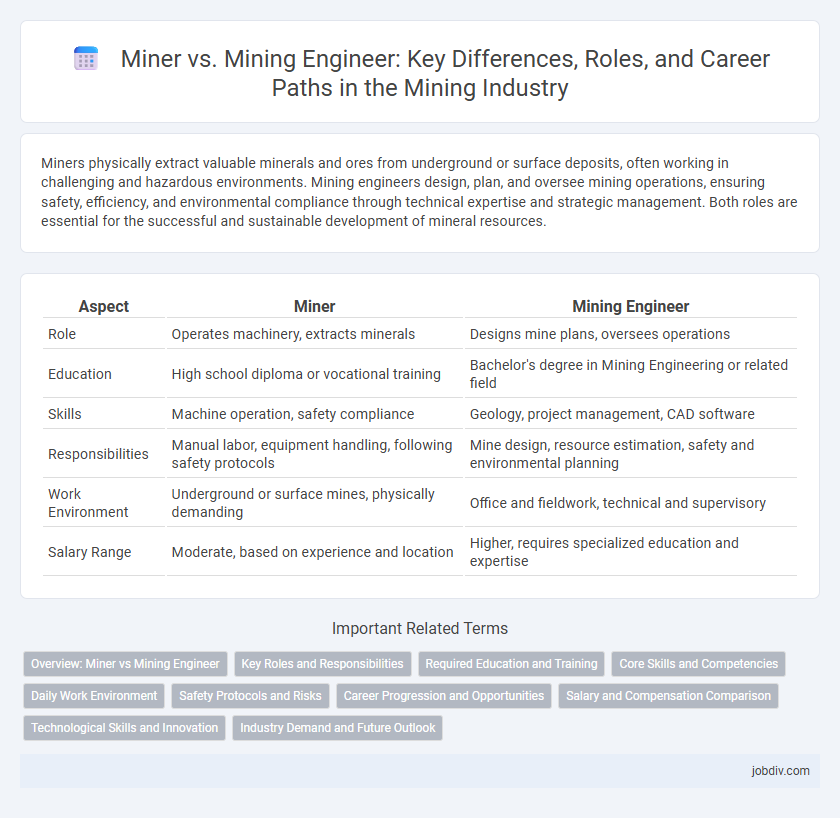Miners physically extract valuable minerals and ores from underground or surface deposits, often working in challenging and hazardous environments. Mining engineers design, plan, and oversee mining operations, ensuring safety, efficiency, and environmental compliance through technical expertise and strategic management. Both roles are essential for the successful and sustainable development of mineral resources.
Table of Comparison
| Aspect | Miner | Mining Engineer |
|---|---|---|
| Role | Operates machinery, extracts minerals | Designs mine plans, oversees operations |
| Education | High school diploma or vocational training | Bachelor's degree in Mining Engineering or related field |
| Skills | Machine operation, safety compliance | Geology, project management, CAD software |
| Responsibilities | Manual labor, equipment handling, following safety protocols | Mine design, resource estimation, safety and environmental planning |
| Work Environment | Underground or surface mines, physically demanding | Office and fieldwork, technical and supervisory |
| Salary Range | Moderate, based on experience and location | Higher, requires specialized education and expertise |
Overview: Miner vs Mining Engineer
Miners physically extract minerals and ores from underground or surface mines, operating heavy machinery and ensuring safety in hazardous conditions. Mining engineers design mining operations, plan extraction processes, and develop sustainable methods to optimize resource recovery while minimizing environmental impact. Both roles are integral to the mining industry, with miners focused on hands-on extraction and engineers on technical planning and management.
Key Roles and Responsibilities
Miners primarily focus on the hands-on extraction of minerals and ores from the earth, operating heavy machinery and ensuring safety protocols underground. Mining engineers are responsible for designing mine structures, planning efficient extraction processes, and overseeing the technical and environmental aspects of mining operations. Both roles are crucial for optimizing productivity, maintaining safety standards, and ensuring sustainable resource management in the mining industry.
Required Education and Training
Miners typically require a high school diploma or equivalent, followed by on-the-job training or vocational courses to gain practical skills in operating mining equipment and ensuring safety. Mining engineers must obtain a bachelor's degree in mining engineering or a related field, which involves in-depth studies in geology, mine design, and resource management, often complemented by internships or cooperative education programs for hands-on experience. Certification and continuing education are crucial for mining engineers to stay updated with technological advancements and regulatory standards in the mining industry.
Core Skills and Competencies
Miners require practical skills in operating heavy machinery, understanding safety protocols, and physically extracting minerals from the earth. Mining Engineers focus on applying technical knowledge in geology, mine design, and resource management to optimize extraction processes and enhance safety. Both roles demand strong problem-solving abilities, but engineers prioritize analytical skills and project planning, while miners emphasize hands-on expertise and adherence to operational procedures.
Daily Work Environment
Miners typically work underground in physically demanding environments, handling extraction and operating heavy machinery, often facing challenging conditions such as limited lighting and ventilation. Mining engineers work primarily in office settings or at sites, using technical expertise to design mines, plan operations, and ensure safety and efficiency through the application of engineering principles. Both roles require coordination, but miners are more focused on the practical execution of extraction activities, while mining engineers concentrate on strategy, project management, and regulatory compliance.
Safety Protocols and Risks
Miners operate directly within extraction sites, facing immediate hazards such as cave-ins, gas exposure, and equipment accidents, necessitating strict adherence to safety protocols like personal protective equipment (PPE) and regular hazard inspections. Mining engineers develop safety plans and risk assessments, designing ventilation systems and emergency response strategies to minimize dangers at mining sites. Both roles prioritize risk mitigation, but mining engineers focus on systemic safety solutions while miners implement practical, on-the-ground precautions.
Career Progression and Opportunities
Miners primarily perform hands-on extraction tasks underground, gaining practical experience that can lead to supervisory roles or specialized operations within mining sites. Mining Engineers focus on designing, planning, and managing mining operations, with career opportunities in project management, safety oversight, and resource evaluation. Advancement for Miners often involves transitioning to technical or leadership positions, while Mining Engineers can progress into senior management, consultancy, or regulatory roles, reflecting their broader scope in mining technology and strategy.
Salary and Compensation Comparison
Miners typically earn a median annual salary of around $45,000, while mining engineers command significantly higher compensation, averaging approximately $95,000 per year due to their specialized skills and responsibilities. Mining engineers benefit from additional perks such as bonuses, profit sharing, and retirement plans, reflecting their critical role in project planning and safety management. Salary variations depend on experience, location, and educational qualifications within both professions.
Technological Skills and Innovation
Miners typically possess hands-on technological skills focused on operating heavy machinery, drilling equipment, and safety systems to extract minerals efficiently. Mining engineers apply advanced technological expertise in designing mining processes, optimizing resource extraction, and integrating innovative software like 3D modeling and automation tools to enhance productivity and safety. The collaboration between miners' practical skills and mining engineers' innovation drives advancements in sustainable mining technologies and operational efficiency.
Industry Demand and Future Outlook
The mining industry shows a growing demand for mining engineers due to their expertise in planning, safety, and environmental management, essential for modern sustainable operations. Miners, responsible for manual extraction, remain critical but face a decline in demand as automation and advanced technology increase efficiency. Future outlook favors mining engineers with skills in digital tools, resource management, and innovation to meet evolving industry standards.
Miner vs Mining Engineer Infographic

 jobdiv.com
jobdiv.com